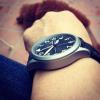Seikosha movement - strange beat per hour
-
Recently Browsing
- No registered users viewing this page.
-
Topics
-
Posts
-
That's very interesting information. I haven't tried to see if my bombé jewel holes have olive holes but I think I should be able to tell on the larger jewels at least. See if I get a chance to have a look later today. This little story was very comforting to read for a "bungler" like myself. That success isn't a given even for a pro. Thanks for sharing!
-
By Michael1962 · Posted
I forgot that I said I would do that. Will take some tomorrow and post them up post haste. -
By nickelsilver · Posted
I've seen some really nice early 20th century pieces where all the jewels, including center wheel, were convex. Definitely to reduce friction. It can be quite hard to tell if a jewel has olive holes, especially on small sizes, but that again reduces friction- as well as accommodates small misalignments better. Why they aren't used more often? I imagine it was found that at a certain point in the train the actual advantage became negligible, and the added cost on high production movements is why it's not seen on those, just higher-end pieces. I did an experiment on a little 5x7"' AS 1012 a few years back. These things run OK sometimes, but often are absolute dogs. And AS made gajillions of them. I had a NOS novelty watch in for a service, ran OK flat, massive drop in amplitude vertical. Made like 3 staffs for it trying different pivot sizes, no change. Tried high quality (not Seitz) convex/olive jewels, no change- the original were flat, but could have been olive hole. Same for the pallet fork, then escape wheel, no change. Probably had 20 hours in the watch, new staff and new hole jewels through the escape wheel, no difference in running. Just a dog of a movement. But if I were making a watch I would use them, just because. -
By Neverenoughwatches · Posted
When Nicklesilver mentioned the use of them on non coned pivots on older high end watches closer to the escapement. That suggested to me probably fourth wheels and possibly third wheels. The square shoulder rotatating on the much smaller surface area of a dome as opposed to a flat jewel surface. I'm curious as to why they are not used predominantly? -
That's what I thought, but as I said, it makes sense. See if any of our pros will have something to add.
-









Recommended Posts